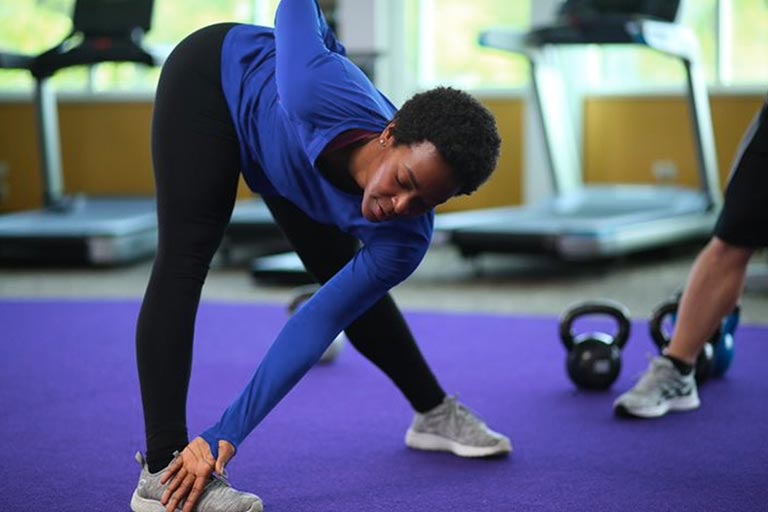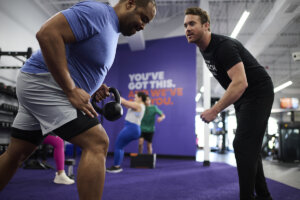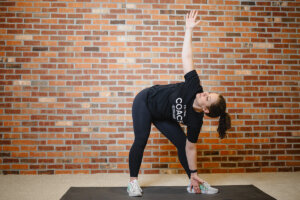If you’ve heard it once, you’ve heard it a thousand times: Don’t skip the warm-up and stretching portion of your workout! We know how tempting it is to jump right into the action — after all, your time is limited, and it’s not like stretching burns a slew of calories or builds a bunch of muscle. But everyone from trainers and athletes to Harvard doctors agree that the warm-up portion of your workout is essential to reducing the risk of injury, as well as increasing blood flow and increasing the flexibility of your joints. That being said, it wasn’t recently that everyone agreed on when stretching should happen.
Should I stretch before a workout?
There’s been a lot of debate over the past decade on whether or not you should stretch before a workout. Stretching, regardless of whether it’s followed by a workout, delivers great benefits. But the answer of “when” isn’t a simple yes or no. This is because there are different types of stretches, each delivering very different results.
What is static stretching?
Static stretching is when you hold an extended muscle for a period of time. Usually it is done after a workout to wind down and neutralize the muscles. While these moves are meant to lengthen your ligaments and muscles gently, doing so while your body is cold could actually cause more harm than good.
Each of your muscles are made up of lots of tiny fibers. When those muscles are pushed, pulled and stretched before they’ve received proper blood flow to meet the demands you’re putting on your body, those fibers tear. Starting cold with static stretches could injure your body before you even make it to the weight bench.
What about dynamic stretching?
Dynamic stretching is much better at preparing your body for working out than static stretching is. Instead of holding a pose, dynamic stretching involves rotating your joints and swinging your appendages for a set amount of time.
Dynamic stretching is stretching with movement, with the movement aligned to the specific workout or sport you’re participating in. For example, hurdlers will use dynamic stretching to slowly rotate their leg over the hurdle, performing the same movement that they will later use during a race. Likewise a quarterback would do a dynamic warm-up with arm circles and by doing throwing motions. A dynamic stretching warm-up is a practice run for your muscles, making it the best type of stretch to do before a workout.
Whether you’re working out first thing in the morning or after spending the day at your desk job, starting your gym routine with gradual warming movements, like dynamic stretches, will set you up for a better workout. And when we say “warmup,” we do mean literally warming your muscles. This is because movement increases blood flow to the areas of your body you’re targeting, while also loosening connective tissues.
Is it better to stretch after a workout?
Just because we don’t recommend static stretching before warming up doesn’t mean you have to say “bye-bye” to your hamstring holds and toe touches. Research shows that stretching after a workout helps your heart rate return to normal and cuts down your sore-muscle recovery time.
What are the benefits of stretching exercises?
We love stretching because the benefits of doing stretching exercises aren’t purely physical. Stretching mentally prepares your mind for what’s coming next in your day, whether you’re leaving the gym or headed to bed. In fact, studies suggest that spending a few minutes stretching and mindful breathing every day helps to reduce anxiety and stress and alleviates muscle tension caused by chronic anxiety.
And of course, stretching has a slew of physical benefits, including:
- Improved blood circulation
- More flexibility and mobility
- Better balance and posture
- Reduced risk of injury
- Relief from muscle tension and fatigue
For those who are preparing for high-impact movements like sprinting, box jumps and hurdles, dynamic stretching minimizes the risk for injury by warming up the muscles. Cold and stiff muscles are more likely to suffer an injury, and the increased blood flow and flexibility that results from warm-up exercises allows for a better range of motion. That range allows you to jump higher, run faster and strength train with better form.
How to warm-up and stretch before your workout
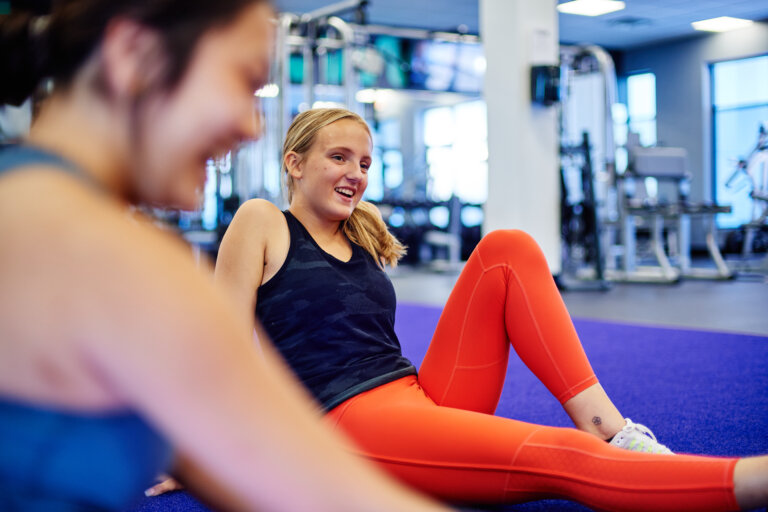
The most important thing to remember when warming up and stretching before you exercise is to take your time and not rush. Moving too quickly leads to cold muscles which could result in poor form, incorrect breathing techniques and accidentally straining or pulling your muscles.
- Start your warm-up with a little cardio. Five minutes on the treadmill or a handful of jumping-jack reps will raise your body temperature gradually.
- Now that your heart rate has increased slightly, do a few dynamic stretches. Stand on a mat and roll your head in circles. Do a few shoulder shrugs. Warm your body up by doing a series of rotations of the arms, hips and torso. Now that the blood is pumping, it’s safe to do more static stretches.
- While standing on your mat, reach down slowly and go as far as you can to reach your toes. Don’t push past the point of comfort. If you’ve just recently added stretching to your workout routine, you may not be able to stretch beyond your knees or calves, but with repetition, the flexibility will come. Repeat the touch-your-toes stretch a couple of times.
- From here, move on to stretch the rest of your muscle groups including:
- Shoulders triceps, and biceps
- Back, spine, and hips
- Quads, calves, it bands, and hamstrings
Let’s walk through popular warm-up stretches to incorporate into your regular routine, from top to toes. Be sure to work each muscle group, but don’t spend more than a minute or two on each.
Arm warm-up stretches
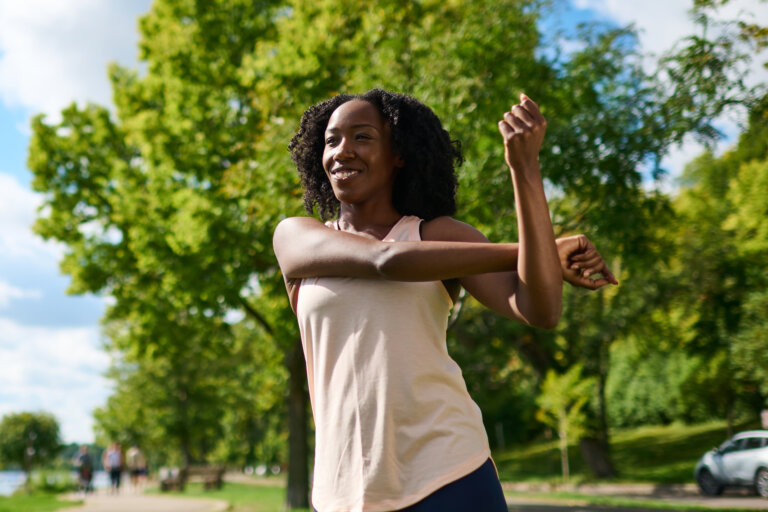
Even if it’s leg day, warming up your arms, shoulder and upper back is crucial to a good workout. Start with dynamic movement to protect your spine, joints and tendons.
Stretches for your shoulder muscles
Before doing static shoulder stretches, try this dynamic move: Rotate your arms in a clockwise motion, keeping your arms relatively straight. Do this for 15-20 rotations, then repeat in a counter-clockwise motion.
Cross-Body Shoulder Stretch
The cross-body shoulder stretch is one of the most well-known stretches out there. We’re willing to bet you’ve been doing this move since elementary gym class. Here’s how it goes:
Stand or sit with a straight back. Extend one arm out and over across the opposite side of your body. Using your other arm, hook the extended arm and pull it closer to your chest. You will feel a stretch in your shoulder. Hold for 20 to 30 seconds, then repeat with the other arm.
Stretches for biceps and triceps
Arm stretches and warm-ups should be a key component to your exercise routine, especially before and after upper body workouts. The main muscles you want to stretch here are your biceps, triceps and forearms.
Overhead Tricep Stretch
Raise your arm over your head. Bending at the elbow, drop your forearm behind your head, reaching your fingers towards the space between your shoulder blades. Use your other hand to gently push your bent arm down until you feel a stretch in your shoulder and your triceps. Hold for 15 to 20 seconds, then switch arms to repeat.
Bicep Wall Stretch
It can be difficult to target the biceps specifically, but the bicep wall stretch is one of the more effective arm stretches. Here’s how:
Find a wall or pole. Place one hand against the wall and slowly turn away from the wall. You can either keep your arm flush to the wall or not. You will feel a pull in your biceps. Adjust the placement of your hand to a higher or lower position on the wall to target different areas of your bicep. Repeat with the other side.
Forearm Stretch
Not only is the forearm stretch the easiest one to do, it’s also the most overlooked. Give these muscles a little love with a gentle stretch.
To work the forearms, extend one of your arms directly in front of you. Keep your arm straight and with the other hand, grab your finger and gently pull back. You will feel the pressure in your wrist and your forearm. Hold for 20 to 30 seconds before releasing and repeating with the other side.
Leg warm-up stretches
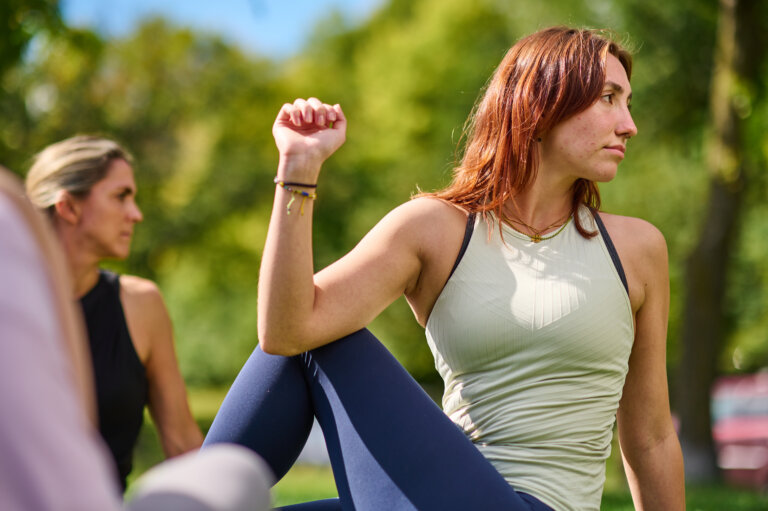
Leg stretches are imperative to your overall fitness regimen because of the amount of stress that’s placed on your legs during exercise. Whether you cycle, run or hit the squat rack, your leg muscles are pushed to their limits throughout your routine. Of course, that pain is (muscle) gain, but without a proper warm-up, you could be putting yourself in more pain than necessary.
Stretching your legs also helps prevent leg cramps, which is when your muscles painfully constrict. Beyond injury prevention, leg stretches make your muscles more flexible, and that flexibility leads to a greater range of motion.
Stretches for your hamstrings
Hamstring stretches not only help prevent pulled hamstrings, but they also reduce strain on your back muscles — they’re all connected, after all. Tight hamstrings are often responsible for lower back pain and lower back pain can cause discomfort in many other areas of your body. Whether you run or lift weights, you probably have experienced soreness in your hamstrings a day or two after. Stretching these muscles before and after exercise can keep this from happening.
Forward Bend
To stretch the hamstrings, stand with your feet shoulder-width apart and slowly reach your hands down and try to touch your toes. Your knees should be slightly bent. Reach as far as you can; you should feel discomfort but not pain. As you reach down past your knees, you should begin to feel your hamstrings stretching. Hold the stretch for a few seconds before releasing and repeating.
Hurdler Stretch
To do the hurdler stretch, sit down on a mat and tuck one leg in. Extend the other leg out in front of you and reach toward your toes with both hands. Hold the position for 10 to 15 seconds before releasing. Repeat with the other leg.
Stretches for the IT band
Your iliotibial or IT band is the tendon that runs down the outer side of your thigh from your hip to your knee. It can be tricky to stretch, but it’s important to try, since stretching can prevent a painful condition known as iliotibial band syndrome, or ITBS. Stretching is actually the way to treat the syndrome, too.
Seated Rotation Stretch
This warm-up exercise is one of the best stretches you can do for the IT band.
Sit down on a mat and extend your legs in front of you. Bend your left knee and cross it over your right leg. Rotate your body touching the outside of your right elbow to the outside of your bent left knee. Look over your left shoulder until you feel a stretch. Hold for 15-20 seconds before switching sides and repeating.
Standing IT-Band Stretch
Stand up straight and cross one leg behind the other leg. Lean toward the other leg, away from the leg that is crossed behind. Lean until you feel the stretch and hold for 20 to 30 seconds. Uncross your legs, release and switch sides to repeat.
Stretches for your calf muscles
Ask any runner, jogger or fast-walker and they’ll tell you that their calves are one of the first things they feel after they’ve finished their route. With your calves being so closely connected to your feet, not wearing supportive footwear won’t only give you sore arches, but sore calf muscles, too. Your calves serve as stabilizers, and if they’re weak, can cause accidents. The right warm-up routine, however, allows you to workout harder and longer.
Calf Stair Stretch
For this move you’ll need to stand on a stair or curb. Stand on the balls of your feet with your heels hanging off the back of the step. Slowly press your heel towards the floor, holding the movement while it stretches the muscles. Repeat 10-15 times.
Downward Dog
This foundational yoga movement is an excellent exercise for stretching the calf muscles.
To get into the downward dog position, get down on all fours with your wrists lined up beneath your shoulders and your knees squared beneath your hips. Transition into a high plank position and then push your hips up and back and hold. Rock back and forth slightly and push to plant your heels on the ground. You will feel your calf muscles stretch. Hold this position for 10-15 seconds, rest, then repeat.
Stretches for your quads
The quad stretch is one of the most intuitive stretches you can do. To stretch your quads, place both feet on the ground. Balancing on one foot, grab your other foot and pull it toward your butt. Your leg should be bent at the knee and you may need to use a wall for balance.
Core warm-up stretches
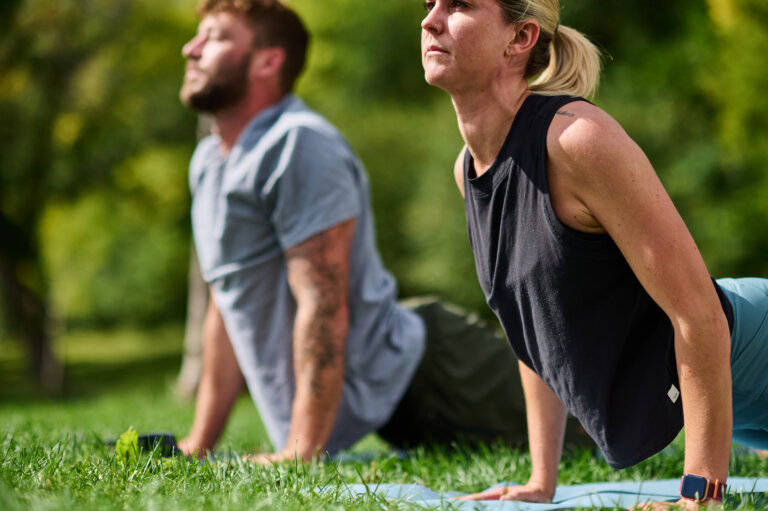
Whether you’re using a rowing machine or grabbing a nearby dumbbell, having good spinal flexibility can greatly improve your workout.
Stretches for your hips
Tight hips aren’t just uncomfortable, they can cause extreme pain in your lower back and in your legs. Sitting all day causes hips to tighten, and because your entire body is connected with the hips, all those hours in your desk chair add up. Even if you’re not working out regularly, you should still take time to stretch your hips daily. You may find that it changes the way your entire body feels.
Forward Runner’s Lunge
To do the runner’s lunge, get into a high-plank position with your shoulders square with your hands that are planted on the floor. Bring your left foot up and step into a deep lunge with your foot outside of your planted hand. Gently rock back and forth and do circular motions in this position. When finished, bring your left foot back into the plank position and repeat on the right side.
90/90 Stretch
Known as the Pigeon Pose in yoga, this move requires a mat. In a seated position, bend one knee in front of you at a 90-degree angle. Your calf should be lined up with your body and your leg should be sitting flat on the mat. Your other leg should be bent at a 90-degree angle behind you. Keep both feet flexed. If you need a deeper stretch, lean forward toward your front leg and bring your forehead to the ground. Hold the position for at least 30 seconds. Switch legs to repeat.
Stretches for your back and spine
Let’s face it, if your back is sore or in pain, your entire body is in pain. Your back is literally the connector to the rest of your body and if it’s not doing so hot, it throws your whole body into whack. There are a lot of stretches you can do, targeting your lower back, upper back, and the space between your shoulder blades.
Seated Spinal Twist
This stretch is similar to the torso rotation for the IT band. It not only works your back but targets your hips, glutes and IT band.
To perform this stretch, sit down and place both legs in front of you. Tuck one leg in, bending at the knee and place your foot to the other side of the still-extended leg. At this point, you can either keep your leg extended or tuck it in. Twist at the spine using your arms to stabilize and deepen the stretch. Repeat on both sides.
Cat-Cow Stretch
This yoga move is easy to do and improves the mobility of your spine.
Grab a mat and get on all fours, also known as Tabletop Position. Look up and invert your spine, pushing your belly toward the ground. Then tuck your chin in and arch your back toward the ceiling. Slowly oscillate between these two movements while inhaling and exhaling.
Backbend Stretch
Using a mat, lay on your stomach with your legs extended behind you and your hands planted on the ground directly below your shoulders. Your face should be almost touching the mat. Slowly raise the top half of your body by extending your arms–almost like a push-up. Your legs should remain extended and touching the mat. While doing this movement, keep your leg muscles and glutes active and engaged. Slowly lower your top half back to the mat and repeat the movement for a few minutes. Not only does this movement stretch, but it strengthens your back, too.
Warm-up stretching: The bottom line
Whether you’re Team Pre-Workout or Post, the more important thing to remember is that movement matters. Adding a stretching routine to your day can significantly improve your mental and physical health. Start with any of these warm-up stretches and you’ll be well on your way to better flexibility, better workouts and better recovery..
Ready to up the ante of your warm-up stretches? Add a foam roller to the mix to really loosen up your body.
